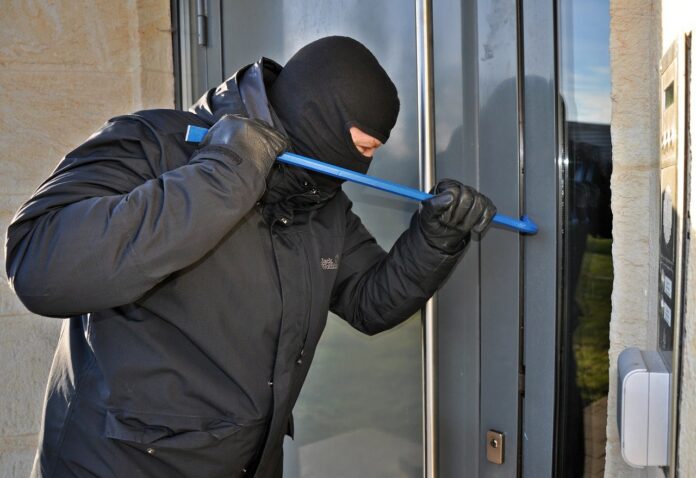Homeowners have been told to protect their homes this summer as new data reveals the locations where residential burglaries are the highest, with a national average of 523 homes targeted by thieves every day.
Cleveland has been named as the residential burglary capital, while Norfolk has been revealed as the safest place for homeowners to avoid theft.
Research by home insurance comparison experts Quotezone.co.uk has revealed the areas where homeowners most need extra security measures, through analysing the latest residential burglary data from each region’s police force.
| Area Name | Household figures (mid-2020) rounded to 100 | Total Residential burglaries in 2022 | Residential burglaries in 2022 per 1000 households |
| Cleveland | 245,100 | 3,765 | 15.4 |
| South Yorkshire | 599,500 | 8,749 | 14.6 |
| Greater Manchester | 1,190,500 | 17,003 | 14.3 |
| West Midlands | 1,148,800 | 15,844 | 13.8 |
| Metropolitan Police | 3,538,700 | 37,724 | 10.7 |
| Humberside | 407,600 | 4,224 | 10.4 |
| West Yorkshire | 964,400 | 9,921 | 10.3 |
| Leicestershire | 438,800 | 3,756 | 8.6 |
| Lancashire | 643,600 | 5,008 | 7.8 |
| Gloucestershire | 275,200 | 2,094 | 7.6 |
| ENGLAND AND WALES | 24,921,000 | 191,094 | 7.9 |
Full table of data available here – https://www.quotezone.co.uk/home-insurance/uk-burglary-hotspots
In the year ending December 2022, a staggering 191,094 residential burglaries were reported in England and Wales.
Cleveland is the area where homeowners are most likely to be targeted, with an average of 15.4 homes out of 1000 being invaded by thieving criminals.
South Yorkshire has the second highest residential burglary rate, with 8,749 reports, equating to 14.6 homes per 1000 households.
Greater Manchester made the top three list, where out of the 1,190,500 households, there were 17,003 reports made to the police.
Reports from the West Midlands police force make it the next most risky area for homeowners, closely followed by London.
The Metropolitan reported an eye-watering 37,724 residential burglaries, the highest of all locations, but given the high volume of households, it has been given the final top-five spot.
The area deemed the safest for homeowners is Norfolk, with just 1,327 reports out of 398,800 households.
Sussex, North Yorkshire and Suffolk also have a lower likelihood of theft, averaging under four burglaries to 1000 households.
Dyfed-Powys Police Force in Wales is the only area with under 1000 reported residential thefts.
Helen Rolph, home insurance comparison expert at Quotezone.co.uk, said: “With police reports showing just how prevalent theft is in England and Wales especially Cleveland and South Yorkshire, homeowners should take all appropriate steps to protect their home.
“With the cost-of-living crisis affecting everyone financially, we’ve noticed a surge in homeowners using home insurance cover without the additional contents protection. This means when burglaries happen, people will be covered for damage to the property but not the items that are stolen.
“Our comparison site can help people compare products and see exactly what’s included per policy – many providers offer contents cover at a competitive price and it can be easily added on.
“When looking to buy a new property, be sure to review the crime rate in that area, obviously people want to ensure they live in as safe an area as possible but just be aware that crime rate can also affect your insurance premiums, such as home and car insurance – those living in areas with a higher crime rate may be paying more.”
Quotezone.co.uk‘s stay safe tips:
- Stay alert
The majority of break ins happen during the day so keep an eye for suspicious behaviour in your neighbourhood and even on the street outside your property – thieves have been known to make symbols in chalk outside a property to help them remember key vulnerabilities. It’s also important not to hesitate in asking callers to the house for their ID, genuine callers won’t mind and it may just put off potential thieves.
- Don’t forget the basics
Even putting in simple security measures can help prevent a break-in as it will take more time for the burglar to gain access to the home. For example, use padlocks, bolts and window locks to tighten up home security; these measures are relatively inexpensive and will help reduce chances of a break-in.
- A door upgrade could add savings
All exterior doors should be double locked every time the house is left unoccupied, even if it’s just for a couple of minutes. uPVC doors and most new doors have a multi-locking system which works when the handle is pulled up and then locked – if they’re BSI approved (British Standards Institution), it can reduce the cost of your home insurance.
- Reduce opportunities
This may seem like an obvious security measure, but making sure anything that is of value, or looks like it could be expensive, is kept fully out of sight from any passers-by, even garden tools and equipment should be locked in the shed or garage as most burglars don’t carry break-in equipment with them. Some homeowners also choose to install frosted glass or net curtains around the front door.
- Alarm details must be accurate
Investing in a burglar alarm is one of the most effective ways to prevent a break-in. Burglars are significantly less likely to target a home which has installed an alarm, and some insurance providers will offer a discount on premiums if the house has one. Just be careful to update your policy correctly, some insurance providers will ask if the alarm is also monitored – inaccurate details could void your policy or hinder your claim.
Quotezone.co.uk helps around 3 million users every year find savings on household bills and essentials, including niche items such as unoccupied home insurance, student contents insurance, and insurance for landlords.
Help keep news FREE for our readers
Supporting your local community newspaper/online news outlet is crucial now more than ever. If you believe in independent journalism, then consider making a valuable contribution by making a one-time or monthly donation. We operate in rural areas where providing unbiased news can be challenging. Read More About Supporting The West Wales Chronicle


























